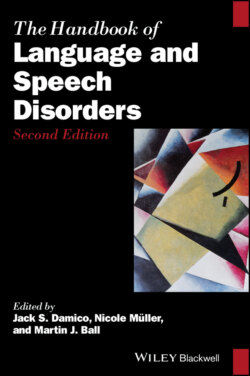Читать книгу The Handbook of Language and Speech Disorders - Группа авторов - Страница 17
1.3 Labeling within a Diagnostic Process
ОглавлениеBased upon labeling theory, it is clear that this social process is active in the diagnostic process within which speech‐language pathologists are frequently engaged; labeling as a specialized circumstance is most evident in the educational and clinical disciplines during those events referred to as “diagnosis.” Since the early 1960s, but especially since the widespread funding of special education in the United States, there has been a tendency to refer students to special education for language‐based learning problems and for communication disorders of various kinds (e.g., Department of Education [DoE], 2002; Kretschmer, 1991; Richardson & Parker, 1993). Similarly, adults with various communication problems are also referred in order to initiate rehabilitation (e.g., Edwards & Bastiaanse, 2007; McDonald, 2007; Thompkins, Marshall, & Phillips, 1980). When an individual (or their caretaker) is in search of an explanation for mental, physical, emotional, or behavioral differences, or when someone seeks assistance with learning or adaptive problems, this individual undergoes a diagnostic process (Flower, 1984). The referral for this evaluation is followed by an assessment process that is intended to provide a diagnostic label.
There have been numerous discussions on the process of evaluation in communication disorders. In general, the process is as follows: (a) a referral is made to the speech‐language pathologist (SLP) by a teacher, nurse, physician, administrator, another professional, or family member; (b) the SLP reviews the referral and determines the types of information that should be collected; (c) an appointment is made for the SLP to evaluate the referred individual in a setting chosen by the professional; (d) a set of tests and other diagnostic procedures are chosen for the assessment session; (e) the assessment is completed at the appointed time(s); (f) the data from the assessment session are combined with any other data obtained by the SLP to provide diagnostic interpretation involving differential and descriptive diagnosis; and (g) a diagnostic label or category is assigned. Once the diagnosis is assigned, then other decisions addressing educational and/or therapeutic issues are considered and implemented.
Following Matsueda (1992) and the idea of reference groups that employ societal mechanisms to justify the diagnostic process and the resulting labels assigned, there are various sanctioned instruments and documents that are employed to justify and legitimize the diagnostic process. Within the diagnostic realm, the first mechanisms of influence developed by individuals in positions of power are instruments like the Diagnostic and Statistical Manual of Mental Disorders published by the American Psychiatric Association, the classifications and position papers published by the American Speech‐Language‐Hearing Association, and codified laws and regulations sanctioned by governmental entities. These documents and codes create an expectation of societal support and need for those perceived deviancies characterized as communication disorders. However, there are other ways that diagnostic labeling is implemented and supported in society: medicalization and diagnostic legitimization. A brief discussion of these two primary and influential mechanisms will demonstrate the subjective nature and the power of labeling.
